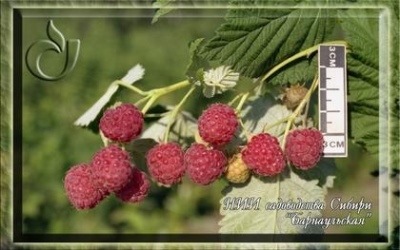
- Authors: NIISS named after M.A. Lisavenko; Lisavenko M.A., Kravtseva N.I., Pavlova N.M., Shein F.T., Anisova V.I.
- Berry color: bright red
- Taste: sweet and sour
- Ripening period: average
- Berry weight, g: 1.9-3.6 gr
- Yield: average 4.75 t / ha, maximum - 7.0 t / ha
- Frost resistance: medium
- Spike location: at the base of the shoots
- Yield rate: high
- Appeared when crossing: Viking x Usanka
Raspberry Barnaul is a very interesting and promising plant. However, one must be able to cultivate it. The article is devoted to the analysis of the main points.
Breeding history of the variety
Barnaul raspberries were bred back in the 1930s at NIISS. The work on the variety was carried out by breeders Lisavenko, Shein, Kravtseva, Pavlova, Anisova. The varieties Viking and Usanka served as the basis for obtaining a hybrid. Since 1961 (according to other sources, since 1978), the variety was entered into the official register, and the tests were completed by 1964. According to the description then adopted, the plant is certified for private farms in the Non-Black Earth Region.
Description of the variety
Ripening terms
The culture has an average ripening rate. The berries ripen almost simultaneously. This allows you to harvest a large crop at once. But sluggish gardeners run the risk of losing it. There are no big problems in favorable weather.
Growing regions
The culture is zoned for:
north of Russia;
northwest;
Ural;
Western Siberia;
East Siberian and Far Eastern regions;
Volga region;
Volga-Vyatka region.
Yield
According to this indicator, the variety is at an average level. Since then, of course, they managed to breed much more prolific varieties. 1 bush accounts for up to 1.5 kg of fruits. In terms of 1 hundred square meters, the total collection can reach 60 kg. But this happens only with careful scrupulous care.
Berries and their taste
Raspberries are painted in a bright scarlet tone. In configuration, they are more like an egg. The mass of one berry is not less than 1.9 and not more than 3.6 g. The variety is characterized by a sweet and sour taste. The soft mass has a dense consistency.
The size of the berries is average; they are of little use for transportation even over a short distance. The surface of the fruit is shiny. Judging by some reviews, they tend to have a spicy rather than sweet and sour taste (although this can be explained by individual perception). Raspberry Barnaul contains a lot of ascorbic acid. The drupes of its berries are small and always tightly linked to each other.

Growing features
Site selection and soil preparation
The plant calmly tolerates even a rather harsh dryness. Like other raspberries, Barnaulskaya cannot survive the cramped conditions. Usually 1 sq. m planted no more than 10 bushes. Before starting work, the earth must be dug 0.3 m deep. In addition, rotted manure, compost, superphosphate are introduced; the size of the planting holes and trenches - 0.4x0.5 m.



Watering and feeding
The crop is responsive to irrigation, especially in early spring. But too intensively it is also hardly worth watering. Fertilization is recommended on initially poor or depleted land. Both organics and mineral complexes are suitable for feeding. There are no other subtleties here.


Frost resistance and preparation for winter
In terms of resistance to cold, Barnaul's raspberry does not stand out with special achievements, but it cannot be considered a heat-loving plant either. The critical temperature is -35 degrees. If this is even theoretically possible, it is better to cover the plant. The working methods are the same as when preparing for the winter of other varieties.

Diseases and pests
The variety resists anthracnose and gray rot well, although it can still become infected with them. But plants can suffer from purple spotting. Spider mites also damage them. And also beware of raspberry gnats and botrytis. In areas where pests are high or diseases are common, it is better to choose other varieties.

Unfortunately, raspberries, like other plants, do not bypass various diseases and pests. Only armed with the knowledge and the necessary means for this, you can cope with such troubles. To help the plant, it is very important to be able to recognize the disease in time and begin timely treatment.
Reproduction
Vegetative reproduction is recognized as the most promising option. It is best to take root shoots for this procedure. It is necessary to separate it from the original bush together with the rhizome. For some time, the planting material is rooted in the greenhouse, and only then in the fall they are planted in a permanent place.








































































